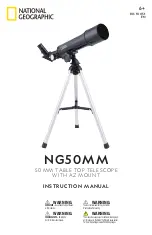
WARNING! Never look directly at t
he sun
either with the naked eye or with t
he telescope!
There is a risk of blinding!
Do not place near windows or in d
irect sunlight.
Magnified light may result in a ri
sk of fire.
WARNING! Not suitable for childr
en under
3 years. Choking hazard — smal
l parts
may be swallowed or inhaled. Ke
ep the
packaging and instructions as th
ey
contain important information.
Galileo G
alilei
My Discovery Telescope
How do you use
a telescope?
Your telescope has a twelve-times magnification
power. This means that you can see objects
roughly twelve times larger through the
telescope than you can with just your eyes alone.
In order to look at an object, hold your telescope
so that the dew shield and the objective lens are
pointing away from you and facing toward the
object. Press the eye cup firmly around either of
your eyes (whichever works best for you) when
you do this. The eye cup is specially shaped and
soft, so you can comfortably press it to your eye
socket. This is ideal for observing things because
it means no light can enter into your eye from the
side. Choose which eye is best for you.
The object that you want to look at should be at
least five meters (or about 15 feet) away. Now use
your other free hand to slide the wide part of the
telescope at the front (called the tube) backward
or forward until you can see the object in focus.
The front of your telescope, which points toward
the object you are looking at, is called the
objective. Here, there is a large converging lens
that bundles the light rays. Inside your telescope,
there are also some rings called baffles. These
allow only the bundled light rays to pass through
the middle and eliminate the light rays around the
edges (called scattered light). At the other end
(the end you look into), there is another lens,
which, on a Galilean telescope, is called a
diverging lens. As this lens is in the eyepiece, it is
called the eyepiece lens or ocular lens (from the
Latin
oculus = eye).
When you slide the two parts of the telescope
toward each other, you are reducing the distance
between the two lenses. This allows you to bring
the image that you want to look at into focus.
© 2010, 2020 Franckh-Kosmos Verlags-GmbH & Co. KG • Pfizerstrasse 5–7 • 70184 Stuttgart,
Germany
This work, including all its parts, is copyright protected. Any use outside the specific limits of
the copyright law without the consent of the publisher is prohibited and punishable by law. This
applies specifically to reproductions, translations, microfilming, and storage and processing in
electronic systems and networks. We do not guarantee that all material in this work is free
from copyright or other protection.
Text: Inka Kiefert and Mark Bachofer
Project management: Dr. Mark Bachofer
Technical product development: Dr. Petra Zimmermann
Manual design concept: Atelier Bea Klenk, Berlin
Manual layout: Mariela Schwerdt, Design & Feinschliff Studio, Stuttgart
Manual illustrations: Friedrich Werth, Horb
Manual photos: dlognord (moon) © fotolia.com; Lucky water (branch); xpixel (moss);
Marco.Warm (beech leaves); Olga Popova (pine branch); Viktor Tyakht (bird) (all previous ©
shutterstock.com); Michael Flaig, Stuttgart (telescope); all others Kosmos Photo Archive
Translation: Stephen O’Connor
Design editing: Pamela Evans, Ted McGuire
Additional packaging design: Dan Freitas
The publisher has made every effort to locate the holders of image rights for all of the photos
used. If in any individual cases any holders of image rights have not been acknowledged, they
are asked to provide evidence to the publisher of their image rights so that they may be paid an
image fee in line with the industry standard.
2nd US Edition © 2019, 2020 Thames & Kosmos, LLC, Providence, RI, USA
Thames & Kosmos® is a registered trademark of Thames & Kosmos, LLC.
Distributed in North America by Thames & Kosmos, LLC. Providence, RI 02903;
Phone: 800-587-2872; Web: www.thamesandkosmos.com
Distributed in United Kingdom by Thames & Kosmos UK LP. Cranbrook, Kent TN17 3HE;
Phone: 01580 713000; Web: www.thamesandkosmos.co.uk
Printed in Taiwan / Imprimé en Taiwan
We reserve the right to make technical changes.
The light rays are a long way apart. You capture these rays using the
objective and the lenses bring them closer and closer together. They
are then so close together in the eyepiece that you can now see
them much more clearly with your eye.
When observing, it helps if you can keep your telescope still. It is not
easy to hold your telescope without wobbling, even though your
telescope is not particularly heavy. Try resting the elbow of the arm
you are using to hold the telescope on a wall, on a parked car, a
stable tree branch, or something similar. It is best to try it out and
see what works best.
Happy
exploring!
Classic refracting telescope (Galilean telescope)
Eyepiece lens
Telescope tube (with baffles inside)
Dew shield
Light rays
Baffles
Eyepiece lens
(Diverging lens)
Objective lens
(Converging lens)
Objective lens
Metal focuser (slide to focus)
Eyepiece with soft eye cup
676
91
9-
02
-3
00
62
0












